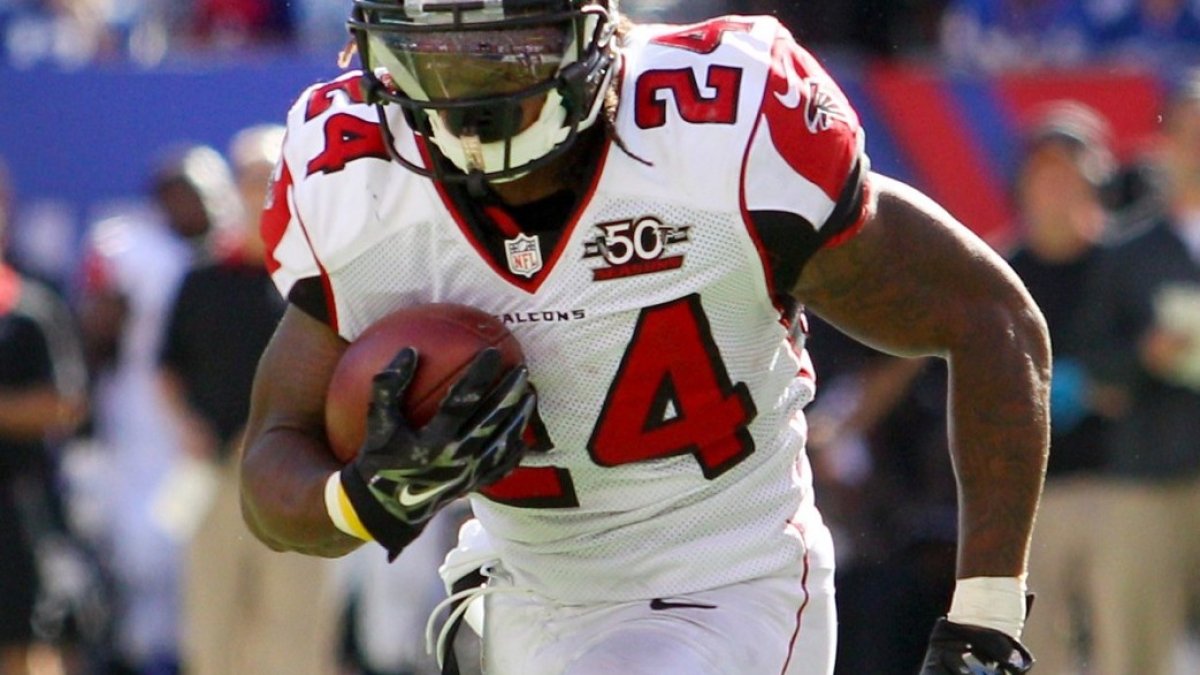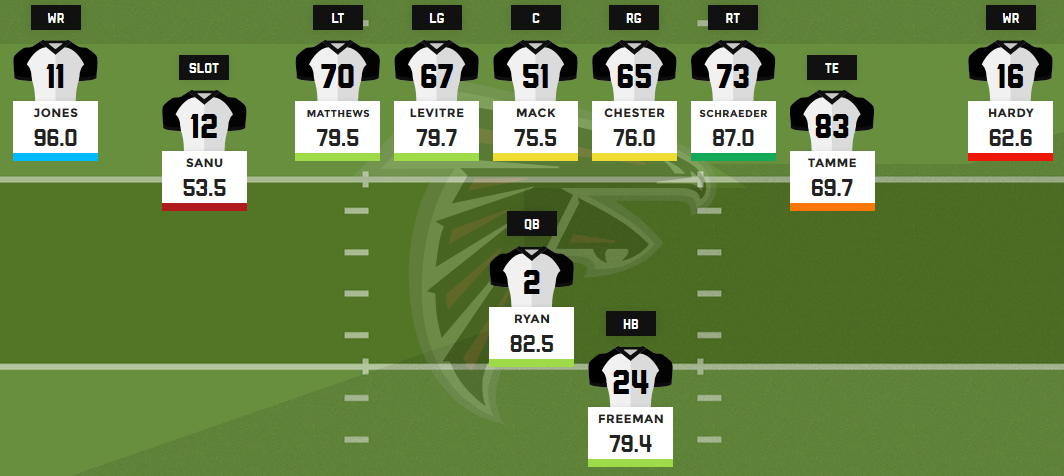(Editor’s note: As we lead up to the season, Director of PFF Fantasy Jeff Ratcliffe is breaking down each team’s depth chart from a fantasy perspective. Catch up on the work so far here.)
Despite producing two of the top fantasy options and ranking seventh in total yards per game last year, the Falcons sputtered at times under new head coach Dan Quinn and finished as the season with a .500 record.
In many ways, Matt Ryan’s statistical performance was a microcosm of the Falcons’ season as a whole. He finished fifth among quarterbacks with 4,591 passing yards, but ranked just 18th in fantasy scoring thanks in large part to a disappointing 21 touchdown passes. A big part of the problem for Ryan was the predictability of the Atlanta offense. With essentially only two weapons on the field, it was fairly easy for the defense to predict where the ball was going. While the Falcons did add a moderate upgrade at receiver in Mohamed Sanu, it’s likely going to be a similar scenario for Ryan this year. He makes for a low upside QB2.
Sanu joins Julio Jones in the Falcons’ wide receiver corps. Jones is coming off a massive 2015 campaign in which he led the league in receiving yards, posting the second-highest single-season total ever. He also forced 20 missed tackles as a runner, which ranked fourth among wide receivers, and led all receivers in yards per route run (3.04). Of course, the big hurdle for Jones is similar to one Calvin Johnson faced during his career. He’s really the Falcons’ only receiving threat, and opposing defenses game plan for him. Even so, Jones is still a top-end fantasy talent and remains an elite WR1.
Atlanta Falcons projected 2016 offense with 2015 grades:
Atlanta attempted to remedy their stars-and-scrubs wide receiver corps with the offseason signing of Sanu. While he isn’t close to what we’d call a “star,” Sanu is an upgrade on what the Falcons had last year. He’s flashed at times with the Bengals, and proved to be a relatively solid receiving option out of the slot. Last season, he tied for eighth in yards after catch per reception (6.3), but ranked just 81st in yards per route run (0.98). However, he wasn’t heavily targeted and has only seen double-digit targets once in his career. Sanu isn’t a sexy option, but he has the potential to return fantasy value in the Falcons’ pass-friendly offense.
The Falcons remain thin beyond Jones and Sanu, with Justin Hardy the likely No. 3 option. Hardy is similar player to former Atlanta receiver Harry Douglas, and will work mainly out of the slot. While Sanu did see a lot of time in the slot in Cincinnati, he also saw his share of snaps on the outside and figures to be in that role in three-wide sets. Hardy isn’t on the fantasy radar at this point.
Jacob Tamme leads the way at tight end. Solid, but extremely unspectacular, Tamme finished tied for 17th among tight ends in fantasy scoring last season. He also ranked 12th in targets. Both are a good measure of Tamme’s ceiling this season. However, we expect him to be a bit closer to his floor, especially after Atlanta drafted Austin Hooper in April. Hooper should immediately push for targets, making Tamme an unappealing fantasy option. Hooper isn’t worth fantasy consideration in 2016, but he’s an intriguing long-term option who display solid ability as a receiver at Stanford.
Entering 2015, Devonta Freeman was largely an afterthought following the Falcons’ draft-day selection of Tevin Coleman. His ADP settled out in the ninth-round range, which was nearly two rounds after Coleman. Well, those who did draft Freeman were rewarded handsomely, especially over the first eight weeks of the season. Over that span, Freeman put up 1,062 total yards and 10 combined touchdowns, scoring 56 more fantasy points than second-place finisher Mark Ingram. For the season, he ranked fifth in the league with 15 runs of 15-plus yards. Freeman also ran the third-most passing routes among running backs (362), and was one of only three running backs to see more than 90 targets.
[Can Freeman come close to his 2015 numbers? Where should he go among running backs? Check out our PFF Draft Master tool and try a mock draft, complete with offensive line grades, full projections and all the PFF data.]
Coleman will factor in on early downs, but Freeman remains the lead dog and is set to see heavy usage again this season. Last year, Freeman touched the ball 338 times. We reduced his workload by 45 touches in our projections, and Freeman still projects as the No. 3 running back in PPR scoring. At this point, Coleman doesn’t figure to be more than a change-of-pace back and fantasy handcuff.
On the defensive side of the ball, the Falcons have a lot of questions at linebacker. Veteran Paul Worrilow has been in the LB2 conversation over the last few seasons, but the team drafted Deion Jones and De’Vondre Campbell. Jones and Worrilow will compete for the starting job in the middle, and Campbell is the front-runner to start on the weak side. The situation is still very much in flux, but whoever emerges as the every-down option will have IDP relevance. Atlanta also added a SS Keanu Neal in April’s draft. He’s a bruising player in the mold of Kam Chancellor. Neal is a strong bet to return DB2 value.



 © 2024 PFF - all rights reserved.
© 2024 PFF - all rights reserved.